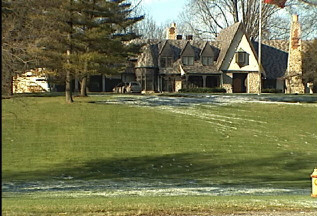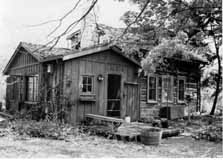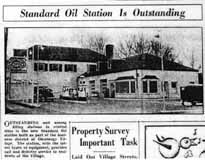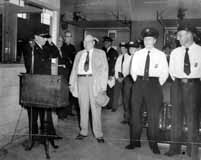September 26th, 2008
 This house was built by Gilbert Hamilton, a real estate developer, in 1927. It sits on Glen Echo Ravine. The Gilbert Hamilton House is a lovely example of a Tudor Revival house, and displays old construction methods and design. The house is on the National Register of Historic Places. (Photo courtesy of the homeowner)
This house was built by Gilbert Hamilton, a real estate developer, in 1927. It sits on Glen Echo Ravine. The Gilbert Hamilton House is a lovely example of a Tudor Revival house, and displays old construction methods and design. The house is on the National Register of Historic Places. (Photo courtesy of the homeowner)
Posted in 1900-1940, Houses | No Comments »
September 26th, 2008
 Orr Zimmerman, who owned the Olympic Swimming Pool, owned the Tudor-style house that still stands on the northwest corner of Henderson and Olentangy River Road. Zimmerman built the house in 1929 on what was then a 52-acre estate; at the time, Henderson was a country gravel road and Olentangy a narrow two-lane street. The architect was Thomas Tulley. Interior walls were decorated by a New York artist, with beautiful wooded scenes in both the trophy room and the living room. Two Canadian bear cubs, captured on a hunting trip, were raised in a small house on the property. In 1977 the house was a Decorators’ Show House.
Orr Zimmerman, who owned the Olympic Swimming Pool, owned the Tudor-style house that still stands on the northwest corner of Henderson and Olentangy River Road. Zimmerman built the house in 1929 on what was then a 52-acre estate; at the time, Henderson was a country gravel road and Olentangy a narrow two-lane street. The architect was Thomas Tulley. Interior walls were decorated by a New York artist, with beautiful wooded scenes in both the trophy room and the living room. Two Canadian bear cubs, captured on a hunting trip, were raised in a small house on the property. In 1977 the house was a Decorators’ Show House.
Posted in 1900-1940, Houses | 1 Comment »
September 26th, 2008
 This diminutive log structure was built in Meigs County in 1840 and brought to Clintonville in 1937 by Grace McGrath, great-granddaughter of the original owner. The house was put next to McGrath’s home. McGrath was an art teacher at Central High School and she used it as an art studio. Subsequent owners have expanded the house with bathrooms, an updated kitchen and bedroom, and porch. (Photo by Inga Smith, photo displayed courtesy of the homeowner)
This diminutive log structure was built in Meigs County in 1840 and brought to Clintonville in 1937 by Grace McGrath, great-granddaughter of the original owner. The house was put next to McGrath’s home. McGrath was an art teacher at Central High School and she used it as an art studio. Subsequent owners have expanded the house with bathrooms, an updated kitchen and bedroom, and porch. (Photo by Inga Smith, photo displayed courtesy of the homeowner)
Posted in 1800s, 1900-1940 | No Comments »
September 26th, 2008
Don Hutslar, in his book Log Construction in the Ohio Country 1750–1850, differentiates between log cabins, which were intended to be temporary, and log houses, which were intended to serve as a home and were consequently sturdier, larger, perhaps taller. I wonder how many log homes there are in Clintonville, covered by contemporary siding. I have been told that there is one at 232 West North Broadway, on the north side of West North Broadway, east of the river.
Posted in 1800s, Houses | No Comments »
September 26th, 2008
 In the early part of the twentieth century, many Clintonville organizations and churches held minstrel shows, as fundraisers and for entertainment. I chose not to sanitize minstrel shows from my book, because they were an authentic part of Clintonville’s history, albeit the part we are all glad we’ve done away with. I regret any offense or hurt caused by these pictures.
In the early part of the twentieth century, many Clintonville organizations and churches held minstrel shows, as fundraisers and for entertainment. I chose not to sanitize minstrel shows from my book, because they were an authentic part of Clintonville’s history, albeit the part we are all glad we’ve done away with. I regret any offense or hurt caused by these pictures.
Tags: Clinton League
Posted in 1900-1940, Organizations, Parks & Recreation | No Comments »
September 26th, 2008
 This cute gas station was located at the northern end of the Olentangy Village shopping area in 1939. Today, it is Oldskool restaurant. Is today’s restaurant the same (original) building? I think so. (Photo courtesy of Melissa Goodrich)
This cute gas station was located at the northern end of the Olentangy Village shopping area in 1939. Today, it is Oldskool restaurant. Is today’s restaurant the same (original) building? I think so. (Photo courtesy of Melissa Goodrich)
Posted in Businesses, Transportation | 1 Comment »
September 26th, 2008
 Old maps show at least 3 “Indian springs” within Clintonville. Overbrook Ravine, one of the Indian springs, was untamed and picturesque. Lore has it that Indians harvested cranberries along the brook. (Photo courtesy of Galen Gonser)
Old maps show at least 3 “Indian springs” within Clintonville. Overbrook Ravine, one of the Indian springs, was untamed and picturesque. Lore has it that Indians harvested cranberries along the brook. (Photo courtesy of Galen Gonser)
Posted in 1900-1940 | No Comments »
September 26th, 2008
 Joe Gratziano owned this market on the corner of North Broadway and High Street. It was a one-story brick building. Until quite recently, this building was still there but covered up. Note the house to the south of Gratziano’s, which exists today. Clinton Theatre had not yet been built.
Joe Gratziano owned this market on the corner of North Broadway and High Street. It was a one-story brick building. Until quite recently, this building was still there but covered up. Note the house to the south of Gratziano’s, which exists today. Clinton Theatre had not yet been built.
Gratziano—or his descendants—eventually moved the market farther south on North High Street. One of the residents on West Como told me that the Gratziano family also operated a market in a building along what is now an alley between Como and Lakeview, north of Milton.
Posted in 1900-1940, Businesses | No Comments »
September 26th, 2008
 This photograph shows the original Engine House 13 (Originally called Chemical House #2) which was located at the southeast corner of North High Street and Wilcox. Built in 1892, it was a 2-bay station with a hose and belltower. In 1898 an addition was built on the station to accommodate a new steamer.
This photograph shows the original Engine House 13 (Originally called Chemical House #2) which was located at the southeast corner of North High Street and Wilcox. Built in 1892, it was a 2-bay station with a hose and belltower. In 1898 an addition was built on the station to accommodate a new steamer.
Tags: North Columbus
Posted in 1900-1940 | 1 Comment »
September 26th, 2008
 The current Engine House #13 was dedicated on September 1, 1957, and is located at Arcadia and Deming. Architect of the current building is Freshwater and Harrison. This is a photograph of the dedication. (Photo courtesy of Central Ohio Fire Museum)
The current Engine House #13 was dedicated on September 1, 1957, and is located at Arcadia and Deming. Architect of the current building is Freshwater and Harrison. This is a photograph of the dedication. (Photo courtesy of Central Ohio Fire Museum)
Posted in 1940-present | No Comments »
 This house was built by Gilbert Hamilton, a real estate developer, in 1927. It sits on Glen Echo Ravine. The Gilbert Hamilton House is a lovely example of a Tudor Revival house, and displays old construction methods and design. The house is on the National Register of Historic Places. (Photo courtesy of the homeowner)
This house was built by Gilbert Hamilton, a real estate developer, in 1927. It sits on Glen Echo Ravine. The Gilbert Hamilton House is a lovely example of a Tudor Revival house, and displays old construction methods and design. The house is on the National Register of Historic Places. (Photo courtesy of the homeowner) Orr Zimmerman, who owned the Olympic Swimming Pool, owned the Tudor-style house that still stands on the northwest corner of Henderson and Olentangy River Road. Zimmerman built the house in 1929 on what was then a 52-acre estate; at the time, Henderson was a country gravel road and Olentangy a narrow two-lane street. The architect was Thomas Tulley. Interior walls were decorated by a New York artist, with beautiful wooded scenes in both the trophy room and the living room. Two Canadian bear cubs, captured on a hunting trip, were raised in a small house on the property. In 1977 the house was a Decorators’ Show House.
Orr Zimmerman, who owned the Olympic Swimming Pool, owned the Tudor-style house that still stands on the northwest corner of Henderson and Olentangy River Road. Zimmerman built the house in 1929 on what was then a 52-acre estate; at the time, Henderson was a country gravel road and Olentangy a narrow two-lane street. The architect was Thomas Tulley. Interior walls were decorated by a New York artist, with beautiful wooded scenes in both the trophy room and the living room. Two Canadian bear cubs, captured on a hunting trip, were raised in a small house on the property. In 1977 the house was a Decorators’ Show House. This diminutive log structure was built in Meigs County in 1840 and brought to Clintonville in 1937 by Grace McGrath, great-granddaughter of the original owner. The house was put next to McGrath’s home. McGrath was an art teacher at Central High School and she used it as an art studio. Subsequent owners have expanded the house with bathrooms, an updated kitchen and bedroom, and porch. (Photo by Inga Smith, photo displayed courtesy of the homeowner)
This diminutive log structure was built in Meigs County in 1840 and brought to Clintonville in 1937 by Grace McGrath, great-granddaughter of the original owner. The house was put next to McGrath’s home. McGrath was an art teacher at Central High School and she used it as an art studio. Subsequent owners have expanded the house with bathrooms, an updated kitchen and bedroom, and porch. (Photo by Inga Smith, photo displayed courtesy of the homeowner) In the early part of the twentieth century, many Clintonville organizations and churches held minstrel shows, as fundraisers and for entertainment. I chose not to sanitize minstrel shows from my book, because they were an authentic part of Clintonville’s history, albeit the part we are all glad we’ve done away with. I regret any offense or hurt caused by these pictures.
In the early part of the twentieth century, many Clintonville organizations and churches held minstrel shows, as fundraisers and for entertainment. I chose not to sanitize minstrel shows from my book, because they were an authentic part of Clintonville’s history, albeit the part we are all glad we’ve done away with. I regret any offense or hurt caused by these pictures. 
 Old maps show at least 3 “Indian springs” within Clintonville. Overbrook Ravine, one of the Indian springs, was untamed and picturesque. Lore has it that Indians harvested cranberries along the brook. (Photo courtesy of Galen Gonser)
Old maps show at least 3 “Indian springs” within Clintonville. Overbrook Ravine, one of the Indian springs, was untamed and picturesque. Lore has it that Indians harvested cranberries along the brook. (Photo courtesy of Galen Gonser) Joe Gratziano owned this market on the corner of North Broadway and High Street. It was a one-story brick building. Until quite recently, this building was still there but covered up. Note the house to the south of Gratziano’s, which exists today. Clinton Theatre had not yet been built.
Joe Gratziano owned this market on the corner of North Broadway and High Street. It was a one-story brick building. Until quite recently, this building was still there but covered up. Note the house to the south of Gratziano’s, which exists today. Clinton Theatre had not yet been built. 

